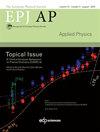Spin transition properties of metal (Zn, Mn) diluted Fe(phen)2(NCS)2 spin-crossover thin films
IF 0.9
4区 物理与天体物理
Q4 PHYSICS, APPLIED
引用次数: 3
Abstract
We report here the effect of metal (Zn and Mn) dilution on the spin transition of Fe(phen)2 (NCS)2 thin film spin-crossover (SCO) complex. The SCO complexes are deposited on glass and indium-tin-oxide (ITO) coated glass by dip-coating technique. The growth of the films is clearly confirmed by the appearance of the sharp optical absorption band at 521–540 nm corresponding to 1 A1g to 1 T1g ligand field absorption of the SCO complex. Although the microstructure of the films remains unaffected by metal dilution, substitution of Fe(II) by either Zn(II) (diamagnetic) or Mn(II) (paramagnetic) results in subtle changes in the bonding environment of the host metal as inferred form X-ray diffraction and Raman studies. The high spin to low spin (or vice versa) transition can be triggered either by electric field or magnetic field as revealed in the measured current (I )–voltage (V ) profile or magnetization data of the films. The data further shows the effect of metal dilution on the spin transition temperatures(T1/2 ), produced hysteresis loop width and loop area, which are the crucial parameter for fabricating spin-based room temperature switching devices.金属(Zn, Mn)稀释Fe(phen)2(NCS)2自旋交叉薄膜的自旋跃迁特性
本文报道了金属(Zn和Mn)稀释对Fe(phen)2 (NCS)2薄膜自旋交叉(SCO)配合物自旋跃迁的影响。采用浸涂技术将SCO配合物沉积在玻璃和氧化铟锡(ITO)镀膜玻璃上。在521-540 nm处出现的尖锐光学吸收带,对应于SCO配合物的1a1g到1t1g配体场吸收,清楚地证实了薄膜的生长。虽然薄膜的微观结构不受金属稀释的影响,但从x射线衍射和拉曼研究中可以推断,用Zn(II)(抗磁性)或Mn(II)(顺磁性)取代Fe(II)会导致宿主金属的键合环境发生微妙变化。高自旋到低自旋(或相反)的转变可以由电场或磁场触发,如测量的电流(I) -电压(V)分布或薄膜的磁化数据所示。数据进一步表明,金属稀释对自旋转变温度(T1/2)、产生的滞后环宽度和环路面积的影响,是制作基于自旋的室温开关器件的关键参数。
本文章由计算机程序翻译,如有差异,请以英文原文为准。
求助全文
约1分钟内获得全文
求助全文
来源期刊
CiteScore
1.90
自引率
10.00%
发文量
84
审稿时长
1.9 months
期刊介绍:
EPJ AP an international journal devoted to the promotion of the recent progresses in all fields of applied physics.
The articles published in EPJ AP span the whole spectrum of applied physics research.

 求助内容:
求助内容: 应助结果提醒方式:
应助结果提醒方式:


